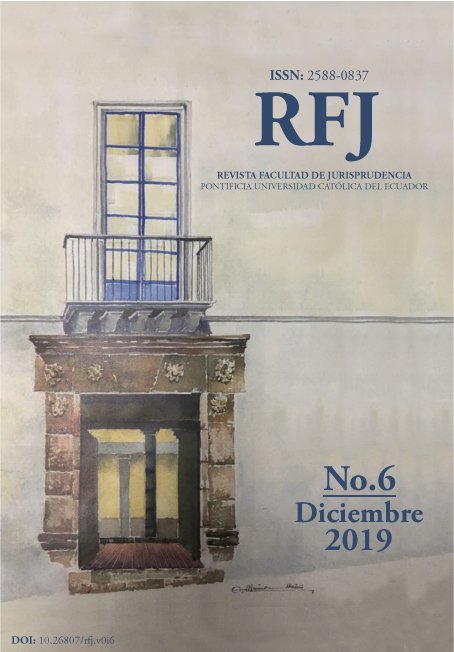La realidad de la prisión preventiva frente a las reformas procesales penales en el Ecuador
Contenido principal del artículo
Resumen
RESUMEN
Este articulo muestra como las reformas procesales penales en el Ecuador acaban en un mejoramiento de la eficiencia del sistema penal, mientras se mantienen o incluso agravan sus debilidades tradicionales como es la arbitrariedad de la privación de la libertad. Mediante el estudio sobre la realidad de la prisión preventiva se puede demostrar no solamente la selectividad en la realización del plan de reformas, sino también la capacidad de resistencia de la cultura jurídica en la Región, el hiperlegalismo y su cumplimiento altamente selectivo, cuales bases materiales e históricas no han sido consideradas por los proveedores internacionales de asistencia. Finalmente, se debe constatar la reconfiguración inquisitorial del sistema adversarial.
ABSTRACT
This article shows how criminal justice reforms in Ecuador lead to an improvement in the efficiency of the criminal justice system, while maintaining or even aggravating its traditional weaknesses, such as the arbitrariness of deprivation of liberty. Through the study of the reality of pre-trial detention, it is possible to demonstrate not only the selectivity in the implementation of the reform plan, but also the resilience of the legal culture in the Region, hyperlegalism and its highly selective compliance, both historical factors that might not have been considered by international assistance providers. Finally, we must verify the inquisitorial reconfiguration of the adversarial system.
KEY WORDS: preventive detention, reforms, procedural system, hyperlegalism, inquisitorial reconfiguration.
JEL CODE / CLASIFICACIÓN JEL: K14
Descargas
Detalles del artículo
Citas
Binder, A. (2012). Presentación, en: Soluciones rápidas y efectivas al conflicto penal, Fortalecimiento de la Justicia en el Ecuador. Quito: Ecuador, p. 11.
Binder, A. (2016). La reforma de la justicia penal en América Latina como política de largo plazo, en Niño Guarnizo C. La Reforma a la Justica en América Latina: Las Lecciones Aprendidas, Bogotá: Colobia, p. 59.
Binder, A. (2016). La reforma de la justicia penal en América Latina como política de largo plazo, p. 56.
Binder, A. (2016). La reforma de la justicia penal en América Latina como política de largo plazo, p. 57.
Binder, A. (2016). La reforma de la justicia penal en América Latina como política de largo plazo, p. 57.
Binder, A. (2016). La reforma de la justicia penal en América Latina como política de largo plazo, p. 60.
Binder, A. (2016). La reforma de la justicia penal en América Latina como política de largo plazo, p. 60.
Carothers, T. (1999). Aiding Democracy Abroad: The Learning Curve, Carnegie Endowment for International Peace. Washington, D.C. p. 305, 107.
Carothers, T. (1999). Aiding Democracy Abroad: The Learning Curve, Carnegie Endowment for International Peace, p. 164.
Carothers, T. (1999). Aiding Democracy Abroad: The Learning Curve, Carnegie Endowment for International Peace. Washington, D.C, p. 102.
Carothers, T. (1999). Aiding Democracy Abroad: The Learning Curve, Carnegie Endowment for International Peace. Washington, D.C.
Comisión Interamericana de Derechos Humanos (2017), Informe sobre medidas dirigidas a reducir el uso de la prisión preventiva en las Américas, p. 15.
Corte Nacional de Justicia, Audiencia del 25 de junio de 2018, No. de proceso: 17721-2018-00012.
Dakolias, M. (1999). Court Performance around the World: A Comparative Perspective, World Bank Technical Paper Number 430. Washington D.C., p. 6.
Dakolias, M. (1999). Court Performance around the World: A Comparative Perspective, World Bank Technical Paper Number 430. Washington D.C., p. 6.
Echeverría, B. (1998). La modernidad del barroco. México, D.F. p. 116.
Echeverría, B. (1998). La modernidad del barroco. México, D.F. p. 117.
Faundez J., Angell, A. (2005). El rol del Banco Interamericano de Desarrollo, Sistemas judiciales, año 4, n킺 8, p. 90-113.
Krauth, S. (2016). La prisión preventiva en el Ecuador, p. 99 í¢€" 120.
Krauth, S. (2018) La prisión preventiva en el Ecuador, Serie Justicia y Defensa 8. Quito: Ecuador.
Margaret, S. (2001). USAIDí¢€â„¢s Support of Justice Reform in Latina America. Pilar Domingo and Rachel Sieder (Eds.), Rule of Law in Latin America: The International Promotion of Judicial Reform. London, p. 75-76.
Margaret, S. (2001). USAIDí¢€â„¢s Support of Justice Reform in Latina America, p 47.
Michel, F. (2012). The Courage of Truth: The Government of Self and Others II; Lectures at the College de France, 1983-1984. New York.
Palacio, D. (2011). La reforma procesal penal en Chile.
Palacio, D. (2011). La reforma procesal penal en Chile: nuevos agentes, sus trayectorias y la reestructuración de un campo. Revista Política, Vol. 49 No. 1, p. 43 í¢€" 70.
Paladines, J. (2013). Fábrica Flagrancia: La gestión procesal de la detención en Ecuador, Justicia Criminal y Democracia. Sí£o Paulo: Brasil, p. 137.
Paladines, J. (2013). Fábrica Flagrancia: La gestión procesal de la detención en Ecuador, Justicia Criminal y Democracia. Sí£o Paulo: Brasil, p. 137.
Pásara, L. (2012). International Support for the Justice Reform in Latin America, Worthwhile or Worthless? Woodrow Wilson Center, Update on the Americas.
Pásara, L. (2012). International Support for the Justice Reform in Latin America, Worthwhile or Worthless?, p. 3.
Pásara, L. (2012). International Support for the Justice Reform in Latin America, Worthwhile or Worthless?, p. 4.
Pásara, L. (2012). International Support for the Justice Reform in Latin America, Worthwhile or Worthless?
Pásara, L. (2012). International Support for the Justice Reform in Latin America, p. 25.
The World Bank. (2004). Initiatives in Legal and Judicial Reform. Washington, D.C, p. 2.
Valle, A. (2016). El habitus positivista en el campo jurídico ecuatoriano. Revista de la Casa de la Cultura N26, p. 145 -172.





